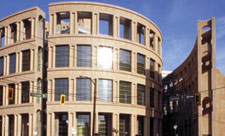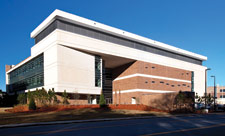Precast Concrete for High Performance Building Envelopes
At the heart of this definition is a fundamental shift in perspective from sustainable design and construction to sustainability and performance on a life-cycle basis. The concept of high-performance encompasses the concepts and practices of sustainability. However, it goes beyond a piecemeal approach by requiring optimization of all relevant attributes for a project. Characteristics such as energy and water conservation, safety, security, and durability are no longer just options, but requirements that must be integrated into a structure's overall design, construction, and performance.
High-performance structures are essential to meeting a variety of demands, and accordingly, green codes and standards, funding entities, and owners are requiring them. Examples include the new International Green Construction Code, LEED (v.4), ASHRAE 189.1, and the mandate by the U.S. Federal Government Executive Order 13514 which requires government buildings to achieve net zero by 2030.
Integral to high-performance structures are high-performance materials and systems—integrated systems that allow for design versatility and are efficient, resilient, and can be optimized to meet the multi-hazard requirements and long-term demands of high-performance structures. Industry watchers maintain that precast concrete is used more and more to help projects meet and exceed their high-performance goals throughout design, construction, and operation.
Precast Concrete Explained
Concrete is a mixture of aggregates (typically sand and stone) that are bound together by a binder. Admixtures or modifying agents and additives are sometimes introduced to improve the characteristics of the fresh concrete, the mixing process, and/or the final hardened material. Precast concrete consists of concrete that is cast into specific shapes at a location other than its final in-service position. It is produced by casting high-strength concrete in a reusable mold or form, which is then cured in a controlled environment at a specially equipped plant.
Precast concrete components are reinforced with either conventional reinforcing steel, steel strands with high tensile strength, or a combination of both. Prestressing is a method of reinforcing where steel strands are pretensioned in the form before the concrete is cast. Once the concrete has cured to a specific strength, the strands are cut, or detensioned. Having bonded to the concrete, the strands attempt to regain their original untensioned length, adding tensile capacity to the precast member that complements concrete's natural strength at resisting compressive forces. This “precompression” increases the load-carrying capacity to the components and helps control cracking to specified limits allowed by the building code.
As a fabricated material, precast concrete continues to evolve as new designs require new solutions and members of the design team push the boundaries of what can be achieved. New admixtures, concrete mixes, fabrication techniques, formliners, and other innovations continue to change and expand the applications of the material and its benefits. In recent years, new capabilities have been added to enhance the uses of the medium, including ultra-high-performance concrete, which provides a compressive strength as high as 30,000 psi.
| High-Performance Precast Envelope System | ||||
Precast concrete is a high-performance material that integrates easily with other systems and inherently provides that versatility, efficiency, and resiliency needed to meet the multi-hazard requirements and long-term demands of high-performance structures.
|
Precast Walls
Precast concrete envelope systems can be used in all types of projects from residential to commercial, to institutional and industrial. They can also be used in everything from low-rise to high-rise construction. Precast concrete wall panels are versatile components that can be used as architectural, structural, or combination elements within a building's design. Wall panels can be designed as loadbearing or non-loadbearing components, and can be used in a number of different structural configurations designed to provide moment and lateral force resistance. Non-loadbearing panels can be attached to any type of structural frame, including precast concrete, cast-in-place concrete, or steel. They can be designed and erected in a horizontal or vertical position.











